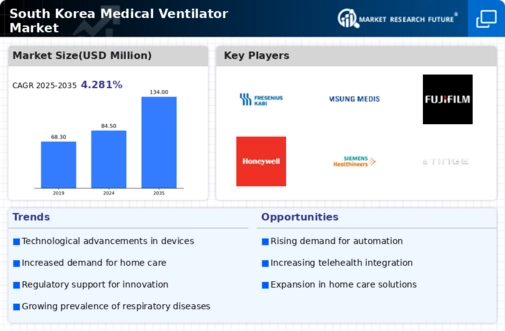Government Initiatives and Funding
Government initiatives aimed at enhancing healthcare infrastructure in South Korea significantly impact the medical ventilator market. The South Korean government has allocated substantial funding to improve respiratory care services, which includes the procurement of modern ventilators. Recent budgets indicate an increase of over 15% in healthcare spending, with a focus on respiratory health. This financial support encourages hospitals and clinics to upgrade their equipment, thereby driving the demand for advanced medical ventilators. Furthermore, public health campaigns aimed at raising awareness about respiratory diseases are likely to contribute to the growth of the market.
Growing Awareness of Home Healthcare
The rising awareness of home healthcare solutions is influencing the medical ventilator market. As patients and families seek alternatives to hospital stays, the demand for portable and user-friendly ventilators is increasing. In South Korea, the home healthcare market is projected to grow by 12% over the next five years, with ventilators being a key component of this trend. This shift towards home care is driven by the desire for comfort and cost-effectiveness, prompting manufacturers to develop devices that cater to this need. Consequently, the medical ventilator market is likely to benefit from this growing segment.
Technological Innovations in Ventilation
Technological innovations play a crucial role in shaping the medical ventilator market. The introduction of smart ventilators equipped with artificial intelligence and machine learning capabilities enhances patient monitoring and care. These advancements allow for more precise adjustments to ventilation settings, improving patient outcomes. In South Korea, the market has seen a surge in demand for such technologically advanced devices, with a projected growth rate of 10% annually. As healthcare providers increasingly adopt these innovations, the medical ventilator market is expected to expand, driven by the need for improved efficiency and effectiveness in respiratory care.
Rising Prevalence of Respiratory Diseases
The increasing incidence of respiratory diseases in South Korea is a primary driver for the medical ventilator market. Conditions such as chronic obstructive pulmonary disease (COPD) and asthma are becoming more prevalent, leading to a heightened demand for ventilatory support. According to health statistics, approximately 7.5% of the population suffers from some form of respiratory ailment, which necessitates the use of ventilators in both hospital and home settings. This trend is likely to continue, as the aging population further exacerbates the situation. The medical ventilator market is expected to grow as healthcare providers seek to equip facilities with advanced ventilatory solutions to manage these conditions effectively.
Aging Population and Increased Healthcare Needs
The aging population in South Korea is a significant driver of the medical ventilator market. As the demographic shifts, the demand for healthcare services, particularly for respiratory support, is expected to rise. By 2025, it is estimated that over 20% of the population will be aged 65 and older, leading to an increased prevalence of age-related respiratory conditions. This demographic trend necessitates the availability of advanced medical ventilators in both clinical and home settings. The medical ventilator market is poised for growth as healthcare systems adapt to meet the needs of this aging population.


















Leave a Comment